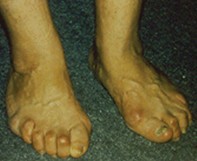Carol’s clawed toes
The motor neuropathy that may occur in patients with diabetes can lead to an imbalance between extensor and flexor function and result in ‘clawing’ of the toes. Here are some issues to consider in managing diabetic patients with neuropathy and clawed toes.
Case history
Carol is 68 years old and has had type 2 diabetes for 16 years with moderate diabetes control (HbA1c values ranging between 7 and 8.5%; ideal less than 7%). She has always beeen embarrassed by her flat feet and over the last few years has developed clawed toes (Figure 1), which she now finds a problem as shoes often rub her toes. She has angina but tries to walk each day on a flat path and at a gentle pace. She is worried about foot infection and knows that poor shoe fit can cause blisters or abrasions that could become infected. She doesn’t feel her toes rubbing, but when she returns from her walk and takes off her court shoes, she can see that her buckled toes are quite reddened.
Carol has reduced dorsalis pedis and posterior tibial pulses in both feet and reduced sensation to her mid foot, but her skin and nails are well cared for. She regrets smoking for some 35 years when she was younger.

